|
St. Petersburg Chamber Opera
The History of the Building
This small, intimate mansion on Galernaya Street which belonged to Baron S. P. von Derviz at the turn of the 20th century has a rich musical and theatrical history.
At the end of the 19th century, the mansion witnessed performances by the House of Interludes, staged by Vsevolod Meierhold, then working under the pseudonym of Doctor Dapertutto. Among those who participated in the performances were the poet and musician M. Kuzmin, the designers N. Sapunov and S. Sudeikin and the artists N. Petrov and B. Kazarova-Volkova. Audiences included such leading cultural figures as K. Stanislavsky, V. Nemirovich-Danchenko, Ye. Vakhtangov and A. Chekhov to name but a few. From 1915, the building was known as the "Theatre and Concert Hall", and there were concerts with F. Chaliapin, L. Sobinov and I. Duncan. The concerts and performances were held in the large White Hall, with its specially equipped stage. Miraculously - after the club-house activities held there in Soviet times - its interior is intact: the baroque mouldings on the walls with sculptures symbolising the arts, Genius swooping over the richly decorated proscenium, a lyre in his hands, and the von Derviz coat of arms on the glass of the great doors.
Other interiors in the mansion have been preserved too, including the luxurious Moorish Drawing Room with its rich gilt embellishment, the Maple Drawing Room with its decorative panelling and the Conservatory designed in the style of an enchanted grotto.
  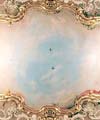  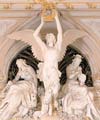
The first owner of the mansion was A. P. Volynsky, the renowned early 18th century statesman and cabinet minister during the reign of Empress Anna Ioannovna who was executed in 1740 for his part in the plot against Duke Biron. The mansion subsequently belonged to his daughter, who married Count I. I. Vorontsov. At various times the mansion was the property of the merchants Schneider and Balabin before Prince Repin became its new owner. In 1870, the architect Miller rebuilt the mansion for L. N. Dolgorukova. In 1876, the mansion was redesigned once again for Mr Vonlyarlyarsky. In 1859, the architect N. P. Grebenka constructed a three-storey dwelling, facing onto Galernaya Street. Baron S. P. von Derviz purchased the property in 1880.
Sergei Pavlovich von Derviz (1863-1918) was a descendent of the ancient Wiese family from Germany. In the mid 18th century, Johann-Adolf Wiese, then working in Sweden, entered the Russian service as a legal counsellor and was elevated to the noble rank of the Holy Roman Empire with the addition of "von der" to his name. His son Sergei held the rank of True Privy Councillor and the title of Chamberlain of the Highest Court. He owned mines and estates in the Kiev, Ryazan and Orienburg Provinces. Both he and his mother were renowned for their work for charity.
The architects P. P. Schreiber and N. B. Nabokov redesigned the property‘s facades both on the English Embankment and Galernaya Street to give it uniformity of style.
The facade on Galernaya Street contains certain elements of the renaissance style, slightly suggestive of a Florentine palazzo.
 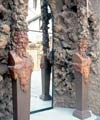 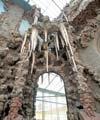 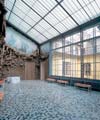 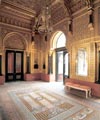
Much attention was lavished on the mansion‘s interiors, which were executed in differing styles according to the fashion of the day. Two floors were added to the embankment side of the property in 1902, obscuring the view of the mansion. In 1909 S. P. von Derviz sold the property, splitting it into three parts. The first was bought by the wife of General Lieutenant A. A. Ignatiev and the left-most section (including the mansion on Galernaya Street) by N. N. Shebeko. The reconstruction of the mansion was planned by the architect A. P. Maximov, and it is in this form that the building survives today.
From 1911-1913 it was home to Meierhold‘s House of Interludes, a fashionable, bohemian theatre-restaurant with a unique repertoire. From 1913 it was the N. Shebeko Theatre Hall. After the Revolution it became the district committee headquarters of the Russian Communist Bolshevik Party, the Union of Metal-Workers and the Estonian House of Enlightenment. From 1946-1991 it housed the Lighthouse club.
On 27th May 2003, the day of St Petersburg‘s tercentenary, and after lengthy repair work, the mansion once again became a "home to theatre", resounding to performances of operas and symphony music and witnessing new productions of the St. Petersburg Chamber Opera Company, founded and directed by Yuri Alexandrov.
     
|
|



